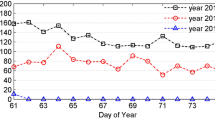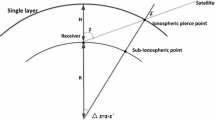Abstract
The mapping function is commonly used to convert slant to vertical total electron content (TEC) based on the assumption that the ionospheric electrons concentrate in a layer. The height of the layer is called ionospheric effective height (IEH) or shell height. The mapping function and IEH are generally well understood for ground-based global navigation satellite system (GNSS) observations, but they are rarely studied for the low earth orbit (LEO) satellite-based TEC conversion. This study is to examine the applicability of three mapping functions for LEO-based GNSS observations. Two IEH calculating methods, namely the centroid method based on the definition of the centroid and the integral method based on one half of the total integral, are discussed. It is found that the IEHs increase linearly with the orbit altitudes ranging from 400 to 1400 km. Model simulations are used to compare the vertical TEC converted by these mapping functions and the vertical TEC directly calculated by the model. Our results illustrate that the F&K (Foelsche and Kirchengast) geometric mapping function together with the IEH from the centroid method is more suitable for the LEO-based TEC conversion, though the thin layer model along with the IEH of the integral method is more appropriate for the ground-based vertical TEC retrieval.









Similar content being viewed by others
References
Astafyeva EI (2009) Dayside ionospheric uplift during strong geomagnetic storms as detected by the CHAMP, SAC-C, TOPEX and Jason-1 satellites. Adv Space Res 43:1749–1756. doi:10.1016/J.ASR.2008.09.036
Bilitza D (2001) International reference ionosphere 2000. Radio Sci 36:261–275. doi:10.1029/2000RS002432
Bilitza D, Reinisch BW (2008) International reference ionosphere 2007: improvements and new parameters. Adv Space Res 42:599–609. doi:10.1016/J.ASR.2007.07.048
Birch MJ, Hargreaves JK, Bailey GJ (2002) On the use of an effective ionospheric height in electron content measurement by GPS reception. Radio Sci 37:1015. doi:10.1029/2000RS002601
Blewitt G (1990) An automatic editing algorithm for GPS data. Geophys Res Lett 17:199–202. doi:10.1029/GL017I003P00199
Carpenter DL (1970) Whistler evidence of the dynamic behavior of the duskside bulge in the plasmasphere. J Geophys Res 75:3837–3847. doi:10.1029/JA075I019P03837
Coster A, Komjathy A (2008) Space weather and the Global Positioning System. Space Weather 6:S06D04. doi:10.1029/2008SW000400
Davies K, Hartmann GK (1997) Studying the ionosphere with the Global Positioning System. Radio Sci 32:1695–1703. doi:10.1029/97RS00451
Foelsche U, Kirchengast G (2002) A simple “geometric” mapping function for the hydrostatic delay at radio frequencies and assessment of its performance. Geophys Res Lett 29:1473. doi:10.1029/2001GL013744
Fox MW (1994) A simple, convenient formalism for electron-density profiles. Radio Sci 29:1473–1491. doi:10.1029/94RS01666
Gallagher DL, Craven PD, Comfort RH (2000) Global core plasma model. J Geophys Res 105:18819–18833. doi:10.1029/1999JA000241
Gulyaeva TL, Gallagher DL (2007) Comparison of two IRI electron-density plasmasphere extensions with GPS-TEC observations. Adv Space Res 39:744–749. doi:10.1016/J.ASR.2007.01.064
Heise S, Jakowski N, Wehrenpfennig A, Reigber C, Lühr H (2002) Sounding of the topside ionosphere/plasmasphere based on GPS measurements from CHAMP: initial results. Geophys Res Lett 29:1699. doi:10.1029/2002GL014738
Hernández-Pajares M, Juan JM, Sanz J, Orus R, Garcia-Rigo A, Feltens J, Komjathy A, Schaer SC, Krankowski A (2009) The IGS VTEC maps: a reliable source of ionospheric information since 1998. J Geod 83:263–275. doi:10.1007/S00190-008-0266-1
Huang Z, Yuan H (2013) Analysis and improvement of ionospheric thin shell model used in SBAS for China region. Adv Space Res 51:2035–2042. doi:10.1016/J.ASR.2012.12.018
Huo X, Yuan Y, Ou J, Zhang K (2011) Monitoring the daytime variations of equatorial ionospheric anomaly using IONEX data and CHAMP GPS data. IEEE Trans Geosci Remote Sens 49:105–114. doi:10.1109/TGRS.2010.2055875
Klobuchar JA (1987) Ionospheric time-delay algorithm for single-frequency GPS users. IEEE Trans Aerop Electron Syst 23:325–331. doi:10.1109/TAES.1987.310829
Klobuchar JA (1996) Ionospheric effects on GPS. In: Parkinson BW, Spilker JJ (eds) Global Positioning System: theory and applications, vol I. Am. Inst. Aeronaut. Astronaut, New York
Lanyi GE, Roth T (1988) A comparison of mapped and measured total ionospheric electron content using Global Positioning System and beacon satellite observations. Radio Sci 23:483–492. doi:10.1029/RS023I004P00483
Lear W (1987) GPS navigation for low-earth orbiting vehicles. NASA 87-FM-2, Rev. 1, JSC-32031, Lyndon B. Johnson Space Center, Houston, Tex
Lee HB, Jee G, Kim YH, Shim JS (2013) Characteristics of global plasmaspheric TEC in comparison with the ionosphere simultaneously observed by Jason-1 satellite. J Geophys Res 118:935–946. doi:10.1002/JGRA.50130
Lei J, Thayer JP, Forbes JM (2010) Longitudinal and geomagnetic activity modulation of the equatorial thermosphere anomaly. J Geophys Res 115:A08311. doi:10.1029/2009JA015177
Lei J, Wang W, Burns AG, Yue X, Dou X, Luan X, Solomon SC, Liu YC-M (2014) New aspects of the ionospheric response to the October 2003 superstorms from multiple-satellite observations. J Geophys Res 119:2298–2317. doi:10.1002/2013JA019575
Mannucci AJ, Wilson BD, Yuan DN, Ho CH, Lindqwister UJ, Runge TF (1998) A global mapping technique for GPS-derived ionospheric total electron content measurements. Radio Sci 33:565–582. doi:10.1029/97RS02707
Mannucci AJ, Tsurutani BT, Iijima BA, Komjathy A, Saito A, Gonzalez WD, Guarnieri FL, Kozyra JU, Skoug R (2005) Dayside global ionospheric response to the major interplanetary events of October 29–30, 2003 “Halloween storms”. Geophys Res Lett 32:L12S02. doi:10.1029/2004GL021467
Montenbruck O, Gill E (2002) Ionospheric correction for GPS tracking of LEO satellites. J Navig 55:293–304. doi:10.1017/S0373463302001789
Noja M, Stolle C, Park J, Lühr H (2013) Long-term analysis of ionospheric polar patches based on CHAMP TEC data. Radio Sci 48:1–13. doi:10.1002/RDS.20033
Pedatella NM, Larson KM (2010) Routine determination of the plasmapause based on COSMIC GPS total electron content observations of the midlatitude trough. J Geophys Res 115:A09301. doi:10.1029/2010JA015265
Sardón E, Rius A, Zarraoa N (1994) Estimation of the transmitter and receiver differential biases and the ionospheric total electron-content from Global Positioning System observations. Radio Sci 29:577–586. doi:10.1029/94RS00449
Schaer S (1999) Mapping and predicting the earth’s ionosphere using the Global Positioning System. Ph.D. dissertation, Astronomical Institute, University of Bern, Bern, Switzerland
Syndergaard S (2002) A new algorithm for retrieving GPS radio occultation total electron content. Geophys Res Lett 29:1808. doi:10.1029/2001GL014478
Tancredi U, Renga A, Grassi M (2014) Geometric total electron content models for topside ionospheric sounding. In: Environmental Energy and Structural Monitoring Systems (EESMS), 2014 IEEE Workshop on, Naples, Italy, 17–18 Sept 2014. IEEE, pp 1–6. doi: 10.1109/EESMS.2014.6923285
Wang Y (2003) A numerical study on the difference of several definitions of shell height in thin-shell model. J Jingzhou Teach Coll (Nat Sci) 26:35–38 (in Chinese)
Wen J, Wan W, Ding F, Yue X, She C, Liu L (2010) Experimental observation and statistical analysis of the vertical TEC mapping function. Chin J Geophys 53:22–29. doi:10.3969/J.ISSN.0001-5733.2010.01.003 (in Chinese)
Yizengaw E, Moldwin MB, Galvan D, Iijima BA, Komjathy A, Mannucci AJ (2008) Global plasmaspheric TEC and its relative contribution to GPS TEC. J Atmos Sol Terr Phys 70:1541–1548. doi:10.1016/J.JASTP.2008.04.022
Yue X, Schreiner WS, Hunt DC, Rocken C, Kuo Y-H (2011) Quantitative evaluation of the low earth orbit satellite based slant total electron content determination. Space Weather 9:S09001. doi:10.1029/2011SW000687
Acknowledgments
This work was supported by the National Natural Science Foundation of China (41325017, 41274157, 41174139 and 41121003), the Project of Chinese Academy of Sciences (KZZD-EW-01), National Key Basic Research Program of China (2012CB825605) and Thousand Young Talents Program of China.
Author information
Authors and Affiliations
Corresponding authors
Rights and permissions
About this article
Cite this article
Zhong, J., Lei, J., Dou, X. et al. Assessment of vertical TEC mapping functions for space-based GNSS observations. GPS Solut 20, 353–362 (2016). https://doi.org/10.1007/s10291-015-0444-6
Received:
Accepted:
Published:
Issue Date:
DOI: https://doi.org/10.1007/s10291-015-0444-6




